Joseph U. Almazan
College of Nursing Health Sciences, Samar State University, Guindapunan, Catbalogan City, Samar, Philippines
Correspondence to: Joseph U. Almazan, College of Nursing Health Sciences, Samar State University, Guindapunan, Catbalogan City, Samar, Philippines.
| Email: |  |
Copyright © 2014 Scientific & Academic Publishing. All Rights Reserved.
Abstract
Almost half the world lives on less than $2.50 a day. Since of the growing poverty incidence around the world, some of the countries made several programs to alleviate the said poverty. One of which is conditional cash transfer programmes (CCT). This study aimed to assess the influence of the conditional cash transfer (CCT) to the living conditions of its beneficiaries. A descriptive correlational research design was utilized in this investigation. The personal outlooks of families enrolled in conditional cash transfer programs (CCT) were undecided. The study population included 161 households’ beneficiaries in the village of Bunu-Anan, Catbalogan City, Samar. The program improves the lives of poor families through cash interventions incentives. The recipients, who were mainly women headed shows affirmation on the requirements of the government as a beneficiary. In identifying relationship personal outlook and their personal variates, it found out that the sex variable shows a significant relationship to the personal outlook. Another show significant relationship in terms of education and monthly family income. The findings should be taken with caution since the program is still on the early years and not directly address the problem in terms of poverty alleviation, and cannot explicitly incorporate impact evaluations.
Keywords:
Conditional cash transfer program, Living conditions, Household beneficiaries
Cite this paper: Joseph U. Almazan, Influence of Conditional Cash Transfer Program to the Living Condition of the Households, International Journal of Psychology and Behavioral Sciences, Vol. 4 No. 5, 2014, pp. 173-178. doi: 10.5923/j.ijpbs.20140405.02.
1. Introduction
Almost half the world, over three billion people, lives on less than $2.50 a day [1]. The poorest 40 percent of the world’s population accounts for 5 percent of global income. Moreover, nearly 1/2 of the world’s population, more than 3 billion people, live on less than $2.50 a day. Moreover, 22,000 children die each day because of poverty. Likewise, More than 1 billion people lack quality access to drinking clean water and an approximately 400 million people are children. Since, unclean water yields illnesses, coarsely 443 million school days are missed every year [2]. Since of the growing poverty incidence around the world, some of the countries made several programs to alleviate the said poverty. One of which is conditional cash transfer program (CCT). It refers in giving money to poor people, and in return for fulfilling specific behavioral conditions. It is a new type of social program with the primary objective of alleviating poverty. It has a direct effect on poverty by providing an immediate additional income for the poor. They can make their own choices as to how to spend or save this money. This is also to have a positive impact on the beneficiary’s education, health, or other socioeconomic well-being, depending on the condition applied. Thereby they help to break the transmission of poverty from one generation to the next [3].The beneficiaries of this program are those of the poor who can meet the conditions. The conditions are in turn often designed to target certain groups within the poorer population rather than everyone. Moreover, it has an incentive to the poor to invest in their own human capital in order to break in the poverty cycle. Education is the most important factors enabling future generations to escape from poverty. Going to school ensures that they will be qualified to find better jobs, and thus lead a better life than their parents [4].In Brazil, the program itself is one of the largest social assistance program in the world. Its evaluations show positive impacts on the reduction of poverty and disparity, subsidizing to the country’s recent progress, and as well as to their level of children’s school attendance. The program to have generated a positive impact on female labor force participation – particularly in the lower-income class [5]. In Chile, the program called Chile Solidario, established in 2002, requires the family to sign a contract to meet specified minimum conditions seen as necessary to overcome extreme poverty. In exchange, the family receives from theprotection bonds, state psychosocial support, guaranteed cash subsidies, and social security programs [6].In United States of America the program is called opportunity NYC family rewards. The program built in the conditional cash transfer (CCT) program. The said family rewards was to test the impact of monetary incentives on children’s education, and family health [7, 8].Meanwhile, in the Philippines, the Conditional Cash Transfer (CCT) Program dubbed as Pantawid Pamilyang Pilipino Program or 4Ps (formerly Ahon Pamilyang Pilipino). This target the poorest among poor families in the region. Economic indicators such as education of the household ownership of assets, type of housing, livelihood of the family and access to water and sanitation facilities are variables to indicate the family economic category [10].Although, there are many studies regarding conditional cash transfer program in the country, however, there are limited studies conducted pertaining to the conditional cash transfer and its influence tothe living conditions of the household benefeciaries in Catbalogan, City, Samar, Philippines. Thus, the researcher was motivated to conduct this study.This study aimed to assess the influence of the conditional cash transfer (CCT) to the living conditions of its beneficiaries.
2. Methods
A descriptive correlational research design was utilized in this investigation. The study population included 161 households beneficiaries in the village of Bunu-Anan, Catbalogan City, Samar.The self-report survey questionnaire composed of the following 1) personal characteristics 2) outlook of the respondents in terms of poverty, inequality and incidence of crime and 3) influence of the program to the living conditions of the grantees in terms of economic sufficiency, social upliftment, and empowerment.Personal characteristics include age, sex, educational background; occupation; monthly family income, family size, and number of years as a beneficiary.In terms of the outlook of the respondents, this includes poverty, inequality and incidence of crime. The five-scale Likert pattern will be used in this part to determine the outlook of the respondent as follows: 5 for strongly agree; 4 for agree; 3 for undecided; 2 for disagree; and 1 for strongly disagree.In terms of influence of the program to the living conditions, it includes economic sufficiency, social upliftment, and empowerment. The five-scale Likert pattern will also be used in this assessment as follows: 5 for extremely influencing; 4 for highly influencing; 3 for moderately influencing; 2 for slightly influencing; and 1 for not influencing.Before the actual data collection, the researcher will coordinate with the Barangay/Village Chairman to identify the specific respondents of the study. A written request will be submitted to him for his cooperation. The approved request will be made reference by the researchers as they interview the beneficiaries one by one.In presenting the profile of the respondents, frequency count, percentage, arithmetic mean and standard deviation, whichever will be applicable, shall be used. In ascertaining the outlook and the influence of the program to their living conditions, the weighted mean will be used to determine the group perception. To ascertain the relationship between the influences of the program to the living conditions of the grantees their personal characteristics, the coefficient of correlation will be employed. Furthermore, to test the significance of the coefficient of correlation, the Fisher’s t-test will be employed. Finally, the α is set at .05 as the level of significance for the area of rejection in a two-tailed test (α/2). For precision and accuracy in the calculations, the researcher will utilize the computer in the data processing. In the analysis, the researchers will use the SPSS version 16 as their statistical software application.
3. Results
Table 1 depicts profile of the respondents, the 6 or 26.1 percent male respondents have an age range of 48-52 years old which is the highest age range among the 23 male respondents. Moreover, 33 or 23.9 female respondents have an age range of 38-42 years old which is the highest age range among the 138 female respondents. Furthermore, 118 or 73. 29 percent of respondents are married, while 6 or 3.73 percent respondents are separated. Meanwhile, more than half of the respondents are high school level with a frequency of 61 or 37. 89 percent. Likewise more than half of the respondents are housewife with a frequency of 100 or 62.11 percent. Similarly, more than half of respondents which account of 105 or 65.22 percent have a family income from Php1, 001 - Php 3,000, the highest number respondents which fall in this income range. Almost half of the respondents have a family size of 2 with a frequency of 75 or 46.58 percent, the highest family size among the 161 respondents. Also, 73 or 45.34 percent of respondents are 3 years already as beneficiaries of the program.Table 1. Profile of the Respondents
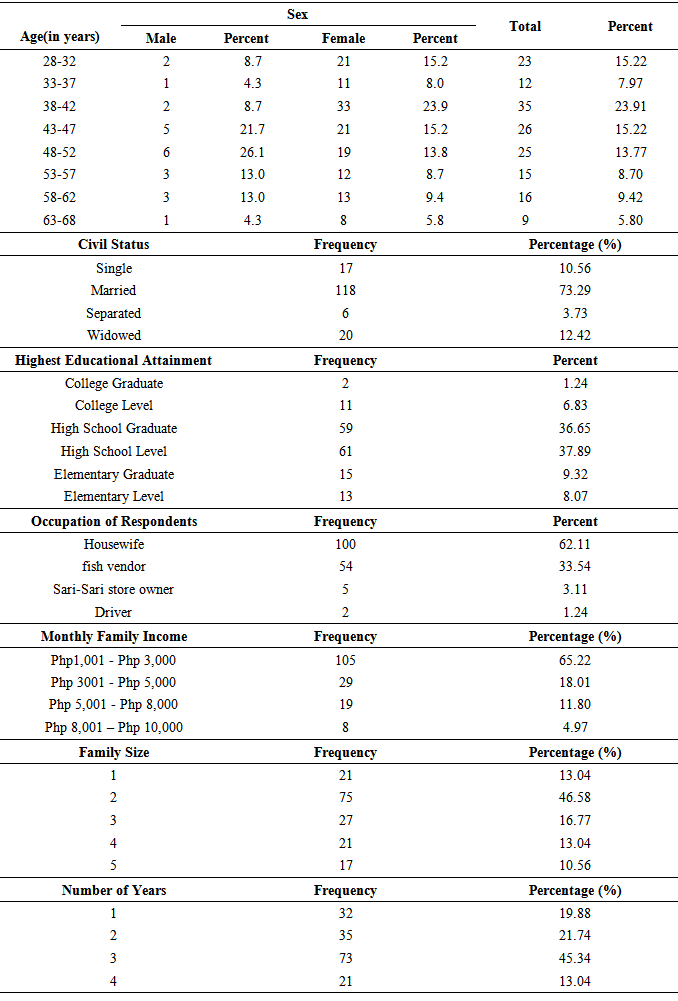 |
| |
|
Reflected of table 2 as to their in the personal outlook, the poverty statement of “My family is poor because we lack resources” posted the highest weighed mean of 2.89, interpreted asundecided. On the inequality statement “My family is not well-known so that we cannot enjoy the things we ought to enjoy” posted the highest weighed mean of 3.01 interpreted as undecided. Lastly, the incidence of crime statement “Greed is within the hearts of the poor because of inequality experienced by them and this gives them the reason to cheat and to do crime” have the highest weighted mean of 2.81, and interpreted as agree. Table 2. Personal Outlook of Respondents
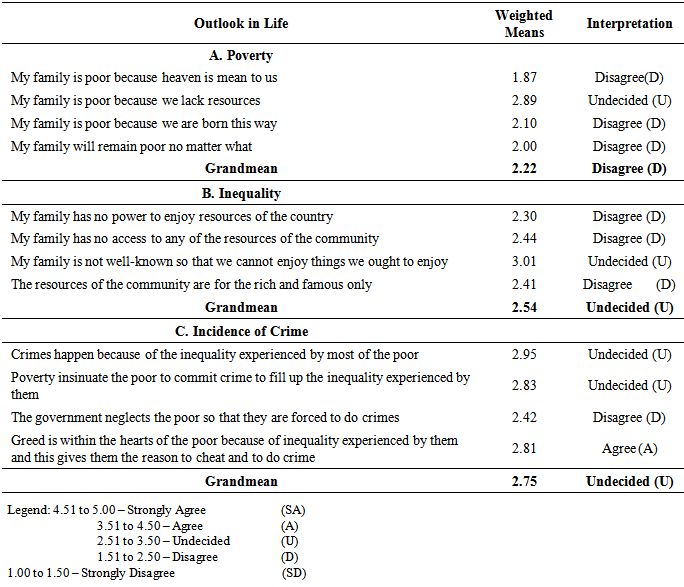 |
| |
|
In table 3 reflected the influence of the CCT to the condition of the respondents, as their economic sufficiency indicators, family income, family sustainability, family member’s health and education, livelihood, have the same interpretation of undecided which posted a weighted mean of 3.27, 3.18, 2.31, 3.22 respectively. Furthermore, social upliftment indicators namely: Social equality, Self-reliance Safety and security, and Belongingness to society have the same interpretations of undecided which posted a weighted mean of 2.89, 2.96,3.02,3.01,2.97 respectively. In addition, empowerment indicators namely: Freedom from the lack and scarcity, Avoidance of crime commission, and Freedom from the thought of committing crime and Ability to think with the right perspective ,have the same interpretations of undecided which posted a weighted mean of 2.63, 2.76, 2.86, 2.83 respectively. Table 3. Influence of the CCT to the Condition of the Respondents
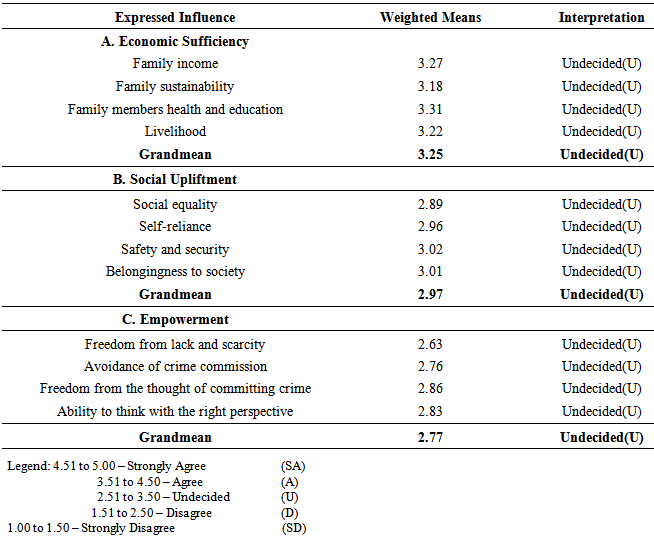 |
| |
|
Table 4 reveals correlations between the personal outlook and their personal variates. The r- value between the correlations of personal outlook and their sex has -0.675, with p-value of 0.001. Furthermore, the correlations of personal outlook and their civil status has 0.589, with p-value of 0.030. Meanwhile, the correlations of personal outlook and their educational background has 0.684, with p-value of 0.012. The r-value between the correlations of personal outlook and their monthly family income has 0.891, with p-value of 0.001 respectively.Table 4. Correlations between the Personal Outlook and their Personal Variates
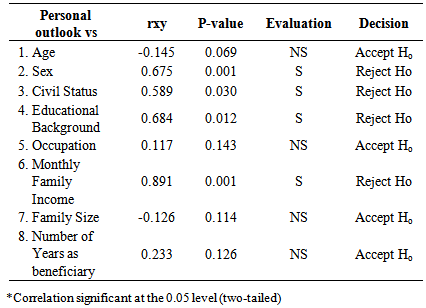 |
| |
|
Table 5 reveals the influence of the program to the condition of the respondents and their profile variates. Meanwhile, the r-value between the correlations of influence of the CCT to the condition of the grantees and its monthly family income has 0.873, with p-value of 0.003. Therefore, there is asignificant relationship between the influence of the program and monthly family income.Table 5. Influence of the Conditional Cash Transfer Programto the Condition and their Profile Variates
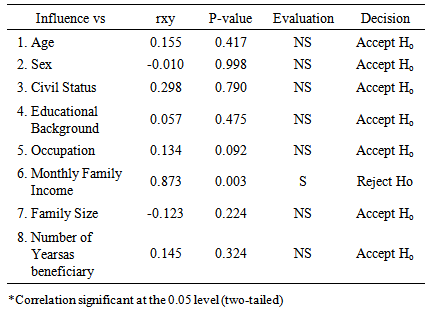 |
| |
|
Table 6 depicts the correlation between personal outlook and influence of the CCT to the condition of the grantees. The r-value between the correlation between personal outlook and influence of the program to the condition of the grantees has -0.158, with p-value of 0.063. Therefore, there is no significant relationship between personal outlook and influence of the program to the condition of the beneficiary. Table 6. Correlation between Personal Outlook and Influence of the Conditional Cash Transfer Program to the Condition to the condition of the Beneficiary
 |
| |
|
4. Discussion
The result of personal outlooks of families enrolled in conditional cash transfer programs (CCT) was undecided. This may be due that the program is still on early years in implementation to the beneficiaries. However, future investigation is needed so that programs can be said both social protection and social investment tools, as they aim to provide immediate economic assistance to the poor and vulnerable in the short term, while encouraging by means of incentives and conditionality, attitude and behavior changes that will theoretically have long-term effects [11].Moreover, the results show that greed indicator gives them the reason to cheat and to do crime in the community. It is worth noting since the previous study that greed is a feeling of not-having-enough, a feeling of hunger-for-more, in a sense of poverty. Greed is a poverty, and one of the worst kind, in that it can never be sated [12].In identifying relationship personal outlook and their personal variates, it found out that the sex variable shows a significant relationship to the personal outlook. This is in worth keeping since the previous study confirm that women enrolled in the program has direct effect especially in their education [13]. Moreover another study pointed out program influence gender relations. Where the main recipients are women, cash transfers have often helped to increase their role in household spending decisions and promote more balanced gender relations. It greatly supports girls’ education by reducing their burden to contribute to the family income and enabling them to participate in school [14]. Another show significant relationship in terms of education and monthly family income. This affirms to the previous study in Mexico that the program improved improves school enrollment and attendance. Likewise, improve enrollment by helping poor households overcome the cost barriers to schooling including fees, uniforms and books. It also reduces the burden on children, particularly girls, to contribute to family income, enabling them to participate in school [15].
5. Conclusions
It can be concluded that the Conditional Cash Transfer Program (CCT) improves the lives of poor families through cash interventions incentives. The cash transfer recipients, who were mainly women headed shows affirmation on the requirements of the government as a beneficiary. Failure to fulfill the requirements causes forfeiture of payments.However, the findings should be taken with caution since the program is still on the early years and not directly address the problem in terms of poverty alleviation, and cannot explicitly incorporate impact evaluations. Results suggest that interventions that focus on investing in basic human capital needs may exert longer term ripple effects families development.
ACKNOWLEDGEMENTS
The researcher would like to thanks all that helped finishing this research article.
References
| [1] | Shah, J. Social, Political, Economic and Environmental Issues. United Nations Development Program, November 27, 2007, p.25. |
| [2] | Global Poverty Retrieved fromhttps://www.dosomething.org/facts/11-facts-about-global-poverty. |
| [3] | Ole D, Ke, X., Carrin G. (2008) retrieved from WHO, GENEVA. [Internet]. Retrived 2008, fromhttp://www.who.int/health_financing/documents/pb_e_08_1-cct.pdf |
| [4] | Ole D, Ke, X., Carrin G. (2008) retrieved from WHO, GENEVA. [Internet]. Retrived 2009. Fromhttp://www.who.int/health_financing/documents/pb_e_08_1-cct.pdf. |
| [5] | Can Conditional Cash Transfers Reduce Poverty and Crime? Evidence from Brazil".[Internet] Retrieved 2012, from https://espe.conference-services.net/resources/321/2907/pdf/ESPE2012_0273_paper.pd. |
| [6] | Palma, J., Urzúa, R., (2014). Anti-poverty Policies and Citizenry: the Chile Solidario Experience .UNESCO Management of Social Transformations Policy Papers/12. Retrieved 2014, fromhttp://www.crm-toolkit.com/welfare-provision-and-funding.html. |
| [7] | Glas R 2014. Opportunity NYC: Family Rewards. Retrieved 2014, from "http://www.opportunitynyc.net/. |
| [8] | Ole D, Ke, X., Carrin G. (2008) retrieved from WHO, GENEVA. [Internet]. Retrieved 2008, from http://www.who.int/health_financing/documents/pb_e_08_1-cct.pdf. |
| [9] | Department of Social Welfare and Development (DSWD) Conditional Cash Transfer (CCT) Philippines - Improving the Human Capital of the Poor (Pantawid Pamilyang Pilipino Program or 4Ps). [Internet]. retrieved 21 January 2009, from,http://unpan1.un.org/intradoc/groups/public/documents/ungc/unpan040549.pdf. |
| [10] | Balisacan A, S. Piza, Mapa D, Santos CA , Odra DM (2010). Tackling Poverty and Social Impacts: Philippine Response to the Global Economic Crisis .Retrieved June 2010, from http://joeyssalceda.files.wordpress.com/2010/06/balisacan_study-revised_final_report_2jun20101.pdf. |
| [11] | Adato M, Hoddinott J (2007). “Conditional Cash Transfer Programs: A Magic Bullet for Reducing Poverty?” 2020 Focus Brief [Internet]. Retrived2007,fromhttp://www.ifpri.org/sites/default/files/Hoddinott_cv_Jul2013.pdf. |
| [12] | Greed leads to poverty. 2011 [Internet]. Retrived 2011 from http://chrisslist.wordpress.com/2010/10/16/greed-leads-to-poverty/. |
| [13] | Darney B, Weaver M, Sandra G. Sosa-R, Walker D, Servan E, Prager S. and Gakidou E.( 2013). The Oportunidades Conditional Cash Transfer Program: Effects on Pregnancy and Contraceptive Use Among Young Rural Women in Mexico RetrievedVolume 39, Number 4, December 2013 http://www.guttmacher.org/pubs/journals/3920513.html. |
| [14] | Adato M, Hoddinott J. (2007). Conditional Cash Transfer Programs: A “Magic Bullet” for Reducing Poverty? 2020 Focus Brief on the World’s Poor and Hungry People. Retrieved October, 2007 fromhttp://www.ministerialleadershipinhealth.org/wp-content/uploads/sites/19/2012/09/CCT-Brief_9-19-12.pdf. |
| [15] | UNDP, Poverty Reduction: Scaling up local innovations for Transformational Change: Mexico: Scaling –up Progresa/ Oportunidades-Conditional Cash Transfer Program. [Internet]. Retrieved November 2011 from http://www.ministerialleadershipinhealth.org/wp-content/uploads/sites/19/2012/09/CCT-Brief_9-19-12.pdf. |
| [16] | The World Bank. Conditional Cash Transfers: Reducing Present and Future Poverty, 2009 [Internet]. Retrieved 2009, fromhttp://www.ministerialleadershipinhealth.org/wp-content/uploads/sites/19/2012/09/CCT-Brief_9-19-12.pdf. |

 Abstract
Abstract Reference
Reference Full-Text PDF
Full-Text PDF Full-text HTML
Full-text HTML




